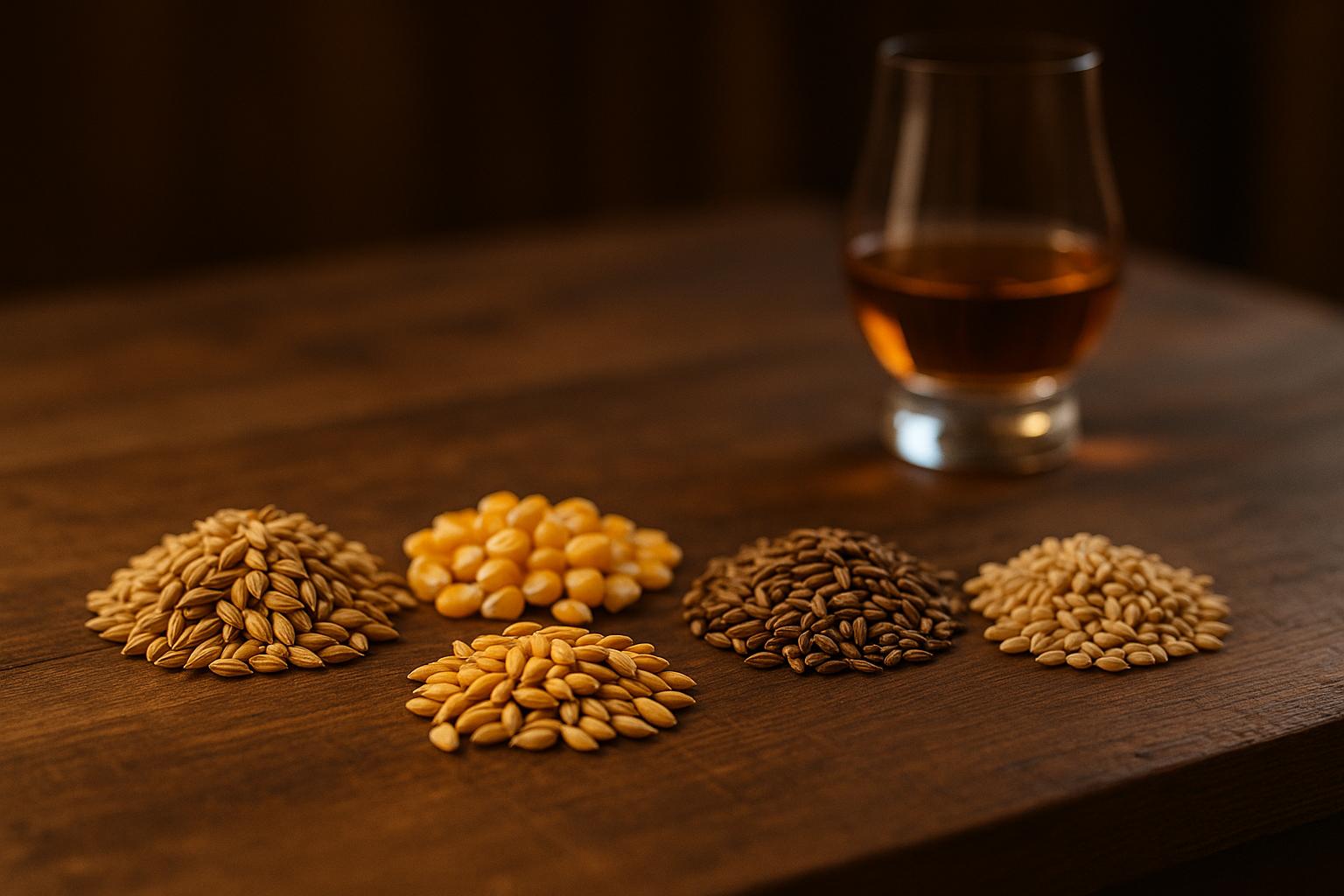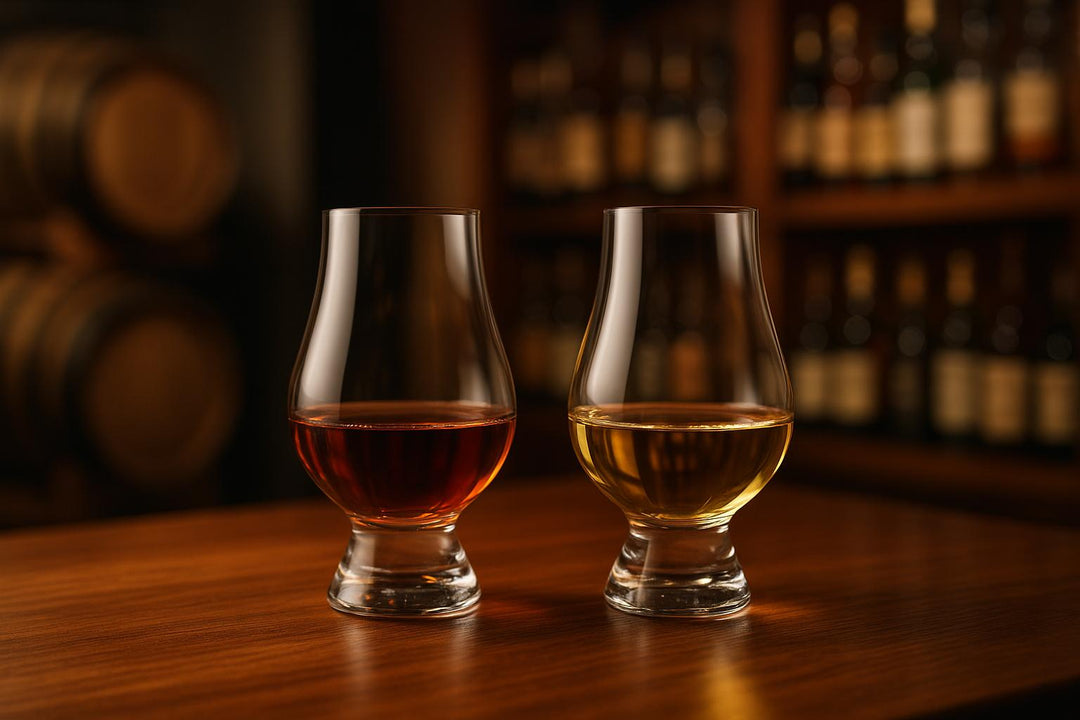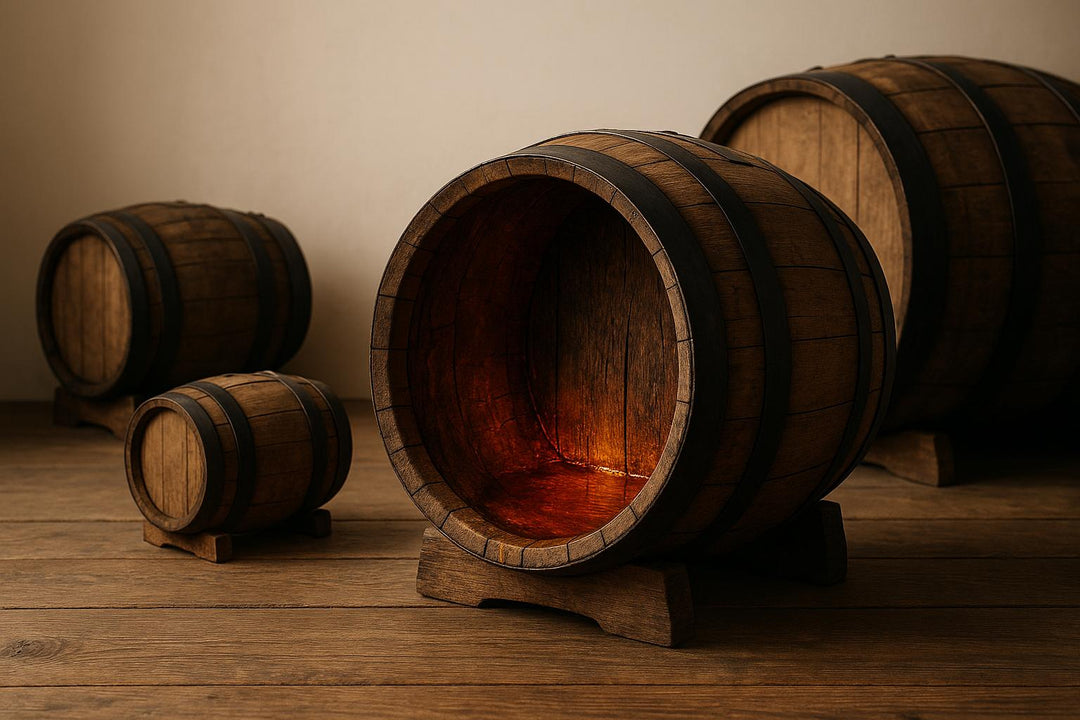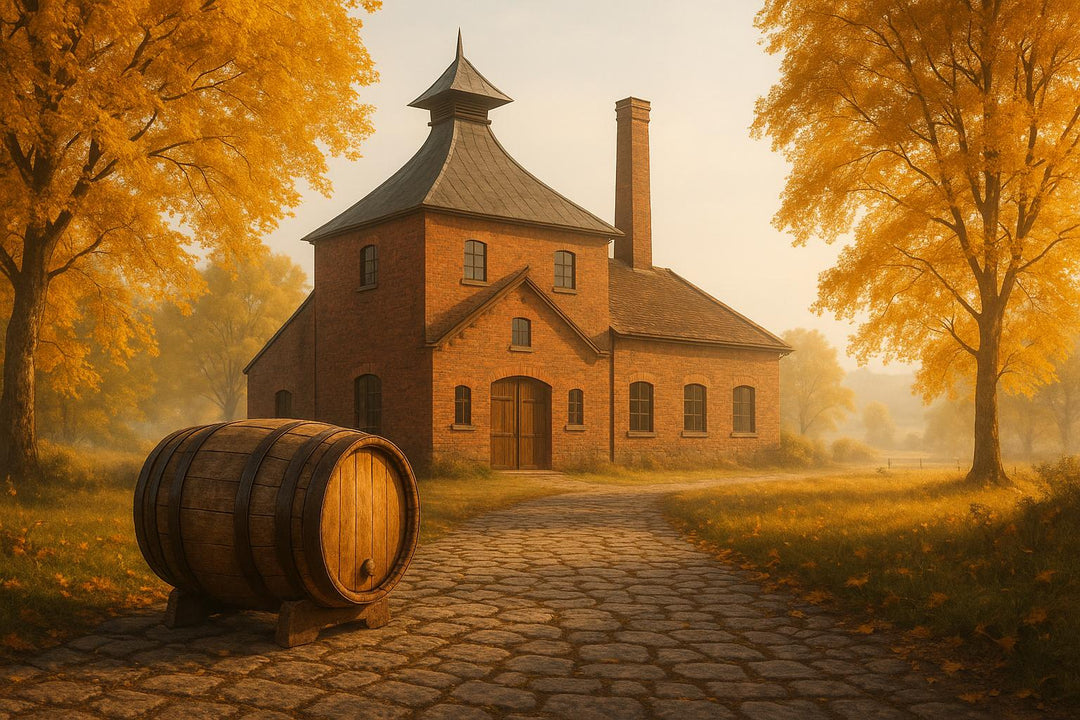The grains used in whisky - barley, corn, rye, and wheat - are the foundation of its flavour and texture. Each grain contributes unique characteristics:
- Barley: Rich, malty, with notes of toffee and caramel.
- Corn: Sweet, smooth, with hints of vanilla and caramel.
- Rye: Bold, spicy, with flavours like cinnamon and clove.
- Wheat: Light, creamy, with subtle honeyed sweetness.
Grain choice influences every stage of whisky production, from malting to distillation, and defines the spirit's character. Regional styles reflect local grain preferences: Scotch relies on barley, bourbon on corn, and rye whisky on its namesake grain. Understanding these differences helps you choose a whisky that matches your taste.
For example:
- Bourbon (51%+ corn): Sweet and mellow.
- Rye whisky (51%+ rye): Spicy and bold.
- Single malt Scotch (100% malted barley): Complex and rich.
Reading labels and experimenting with styles can deepen your appreciation for this grain-driven craft.
Main Grains Used in Whisky and Their Flavours
The choice of grains in whisky production plays a huge role in shaping its flavour. Each grain brings its own distinct characteristics - whether it's maltiness, sweetness, spice, or creaminess - that contribute to the spirit's overall personality. These profiles influence every stage, from fermentation to distillation, and ultimately define the whisky's character.
Malted Barley
Malted barley is the backbone of single malt Scotch whisky, which is crafted exclusively from 100% malted barley. The malting process activates enzymes that convert the grain's starches into fermentable sugars, setting the stage for fermentation.
The resulting flavours are rich, with biscuity and nutty notes. When peat is used during the drying process, it introduces smoky, earthy undertones - a hallmark of many Islay and Highland whiskies. Even in small amounts, such as in a bourbon with 20% barley, it can add layers of caramel, vanilla, and toasted oak to the mix.
Corn
Corn is a cornerstone of American whisky, particularly bourbon, which legally requires a mash bill of at least 51% corn. This grain is largely responsible for bourbon’s characteristic sweetness and smooth, approachable profile.
Corn contributes flavours of vanilla, caramel, and a creamy, buttery sweetness. It creates a soft base that balances the bolder elements of the whisky, making corn-heavy spirits especially appealing to those new to whisky.
Rye
Rye adds boldness and depth, bringing a spicy complexity to whisky. In American rye whisky, the mash must contain at least 51% rye, though even smaller amounts can leave a significant imprint.
Rye's flavour profile is unmistakably spicy and peppery, often with notes of black pepper, clove, and allspice. Its dry, earthy character provides a striking contrast to sweetness, adding layers that evolve beautifully over time.
Wheat
Wheat is known for producing a whisky that is smooth and mellow. When used as a secondary grain in "wheated" bourbons, it softens the overall profile, creating a rounded and approachable spirit.
Wheat's flavours often include honey, berries, butterscotch, and toffee. It acts as a natural smoothing agent, mellowing out any harsh edges and leaving a creamy, velvety texture on the palate.
Other Grains (Triticale, Oats)
For those seeking something a bit different, grains like triticale and oats offer exciting new flavour possibilities.
Triticale, a hybrid of wheat and rye developed in Scotland in 1875, combines the sweetness of wheat with rye’s spiciness. Laura Fields from Dram Devotees highlights its unique qualities:
"Triticale has proven to be a remarkable grain for whisky production because it doesn't need to be boiled before mashing. It takes the spiciness of rye and soothes and rounds it out with its wheat influence."
Monashee Spirits Craft Distillery describes triticale as having a bold flavour profile, blending wheat's sweetness with rye's spice, along with hints of stewed fruits, vanilla, and festive spices reminiscent of Christmas cake.
Oat whisky, on the other hand, leans into its natural sweetness. High West’s Silver Whisky Western Oat, made with 85% oats and 15% malted barley, showcases this grain’s potential. Without the influence of extended wood ageing, oat whiskies often highlight a pronounced sweetness, likely tied to the grain's residual sugars or unique chemical properties.
These alternative grains are pushing the boundaries of whisky-making, offering distillers fresh opportunities to craft distinctive flavours. While they challenge traditional norms, they still stay true to the essence of what makes whisky so beloved.
The Malting Process and Flavour Development
Malting is where the journey of raw grains begins, transforming into the complex flavours that define whisky. This process not only prepares the grain for fermentation but also plays a key role in shaping the character of the final spirit through a series of controlled steps.
Steps in the Malting Process
Malting unfolds in three main stages. It starts with steeping, where grains are soaked in water to trigger germination. This activates enzymes that break down starches into fermentable sugars, setting the stage for fermentation.
The second stage, germination, usually lasts 4 to 6 days. During this time, the grains sprout, and their stored starches are converted into simpler sugars that yeast can later consume. Temperature and moisture levels need to be carefully maintained to ensure optimal enzyme activity and sugar production.
Finally, there’s kilning, where the grains are dried to halt germination and preserve the malt. This step is crucial for flavour development. Lower kilning temperatures, used for pale malts, result in sweet, fruity notes often found in single malts. On the other hand, higher temperatures, like those used for crystal or caramel malts, bring out deeper flavours such as toffee, raisin, and burnt sugar. The highest temperatures, applied to chocolate and roasted barley, create smoky, roasted, or coffee-like characteristics.
Traditional maltings, particularly smaller ones, often produce malt with unique flavour profiles due to less precise climate control. These steps lay the groundwork for further flavour refinement, influenced by factors like peat and barley selection.
Impact of Peat and Barley Varieties
After kilning, two key elements - peat and barley - further shape the malt’s character. Peat, a hallmark of Scottish whisky, is especially important. When malted grain is dried over a peat fire, it absorbs smoky compounds that define many single malts. The intensity of this smokiness depends on the type of peat and the drying duration. For example, Islay peat imparts medicinal and maritime notes, while Highland peat leans towards earthier, vegetal flavours.
Barley varieties also play a significant role. Scottish distillers often use two-row barley, prized for its balanced profile, consistent enzyme levels, and flavour potential. The specific barley strain chosen influences not only how efficiently starches are converted but also the subtle flavour nuances that emerge during malting.
At Levenbank distillery, for instance, varying kilning techniques demonstrate how small adjustments can produce vastly different results - from fruity to smoky or even coffee-like profiles - all from the same grain. While two-row barley’s high enzyme content aids efficient starch conversion, higher kilning temperatures can reduce enzyme activity. Distillers must carefully balance flavour development with fermentation needs, showcasing the skill and precision behind traditional whisky-making.
Grain Impact Comparison: A Quick Reference Guide
Building on our earlier look at grains in whisky production, here's a side-by-side comparison to highlight how each grain shapes a whisky's character. Every grain contributes distinct flavours, textures, and regional traditions, giving whiskies their unique identities.
Grain Flavour Profile Table
The table below outlines the key traits of each grain, helping you anticipate the flavour and texture of different whisky styles.
| Grain | Flavour Profile | Texture | Regional Usage | Legal Requirements |
|---|---|---|---|---|
| Malted Barley | Malty, biscuity, nutty, cereal sweetness, fruity notes | Smooth | Scotch, Irish whisky | 100% in single malt Scotch |
| Corn | Sweet, vanilla, caramel, toffee | Full-bodied, soft | Bourbon, Canadian whisky | Minimum 51% in Bourbon |
| Rye | Spicy, peppery, clove, cinnamon | Crisp | American and Canadian whiskies | Minimum 51% in Rye whisky |
| Wheat | Soft, sweet, honey-baked bread, caramel, vanilla, toffee | Smooth, velvety | Wheated Bourbons, some Canadian whiskies | Minimum 51% in Wheat whisky |
The mash bill – the specific combination of grains used – is the backbone of a whisky's character. For instance, a high-rye bourbon will bring bold spice, while a wheated bourbon offers a softer, gentler profile. Knowing how these grains influence flavour can give you a good idea of what to expect before you even pour a dram.
If you're intrigued by grain-forward whiskies, check out The Really Good Whisky Company for a curated selection that showcases these distinctive profiles (https://reallygoodwhisky.com).
sbb-itb-128d6c1
How to Choose Grain-Forward Whiskies
Understanding how grains influence whisky profiles can help you pick a bottle that suits your taste - whether you lean towards rye's bold spice or wheat's mellow sweetness.
Reading Whisky Labels for Grain Types
Whisky labels hold the key to understanding a bottle’s grain makeup. For instance, a Single Malt label means the whisky is made from 100% malted barley at a single distillery, offering a pure expression of barley’s flavour. On the other hand, Bourbons and Rye whiskies must include at least 51% of their respective grains, ensuring their dominant character shines through.
If you see Wheated Bourbon, it means wheat replaces rye as the secondary grain, resulting in a softer, more approachable whisky.
"By learning how to read a whiskey label, you'll be prepared to make sound purchases and confident in your selections." - Stephanie Moreno
The word Straight on American whisky labels indicates the whisky has been aged for at least two years in new, charred oak barrels, which significantly impacts how the grain flavours develop. Some bottles even list the mash bill - the percentage breakdown of grains used - giving you a detailed preview of the flavour profile.
Be cautious with terms like Small Batch and Craft, as they lack legal definitions and can be misleading. Instead, focus on the grain details and carefully read product descriptions to understand how specific grains influence the whisky’s taste.
Once you’ve cracked the code on labels, dive into bottles that highlight individual grains.
Best Whiskies That Showcase Specific Grains
Certain whiskies are exceptional at spotlighting the unique characteristics of individual grains. For wheat lovers, Maker's Mark is a classic choice. Its creamy texture and gentle sweetness beautifully demonstrate wheat’s soft, smooth qualities.
If rye is your preference, High Wire New Southern Revival Rye delivers a bold, spicy profile with notes of dark fruit, spearmint, anise, and pine. Made with 100% Wrens Abruzzi rye, it’s a pure showcase of rye’s peppery intensity.
Corn takes centre stage in High Wire Jimmy Red Bottled-In-Bond Bourbon, crafted entirely from Jimmy Red corn. This bourbon bursts with sweet flavours like butterscotch, vanilla, caramel, and candied cherries, highlighting corn’s natural richness.
For a unique take on corn, Bain's Cape Mountain Whisky offers a South African twist with notes of vanilla, toffee, buttery popcorn, and corn-on-the-cob - a perfect example of how geography influences flavour.
Looking for something unconventional? Koval Single Barrel Millet uses millet to create a distinct profile, featuring hints of spice, anise, vanilla, and pine resin. It’s a great way to explore how alternative grains can bring something entirely different to the table.
After selecting your whisky, use these tasting techniques to uncover its grain story.
Tasting Tips for Grain Characteristics
To truly appreciate a whisky’s grain profile, start by nosing it three times. Each sniff can reveal new layers, helping you pick up on subtle grain notes.
Side-by-side tastings are incredibly helpful. Compare a high-rye bourbon with a wheated bourbon, or a single malt with a grain whisky. This contrast makes it easier to pinpoint the unique contributions of each grain.
Patience is key - let the whisky breathe for about 30 minutes. As it opens up, you might notice corn’s vanilla sweetness or rye’s peppery depth emerging more clearly. Adding a splash of water can also unlock hidden flavours, so experiment with different dilution levels.
Finally, expand your flavour vocabulary by sampling a variety of foods and spices. Recognising cinnamon, vanilla, or black pepper in your meals can sharpen your ability to identify these same notes in whisky. And don’t second-guess yourself - your palate is unique, so trust what you taste, even if it surprises you.
For a curated selection of whiskies that highlight these grain profiles, check out The Really Good Whisky Company, where you can explore how different grains shape the character of each bottle.
Conclusion: Why Grain Selection Matters in Whisky
Grain selection is the bedrock of every great whisky, influencing everything from its aroma to the lingering finish. When you understand the role of grains, your whisky journey evolves from casual enjoyment to a deeper, more informed appreciation.
Take bourbon and rye whiskies, for example. By law, bourbon must include at least 51% corn, while rye whisky requires a minimum of 51% rye. These rules aren't just technicalities - they're what ensure each whisky style delivers its hallmark flavour. But the artistry goes far beyond these guidelines. Distillers experiment with grain ratios, revive heritage grains, and even incorporate less common grains like oats. Every decision impacts the entire process, shaping fermentation, distillation, and how the spirit interacts with oak barrels during maturation. These choices resonate in every sip, offering layers of complexity for those ready to explore.
Understanding these grain profiles allows you to better appreciate the distiller's craft. You might notice how a wheated bourbon feels softer and more mellow compared to a rye-forward one. Or how single malt Scotch, made exclusively from malted barley, presents a completely different flavour spectrum compared to blended American grain whiskies.
"Just as a painter uses colour or a chef blends flavours, distillers select various grains to create distinctive whisky profiles."
- Colby Frey, Whisky Farmer and Co-founder of Frey Ranch Distillery
"The fun part about whisky is appreciating how vast and diverse the category has become."
- Colby Frey, Whisky Farmer and Co-founder of Frey Ranch Distillery
Frey's words capture the thrill of exploring whisky through its grains. Whether you're drawn to the sweetness of corn, the bold spice of rye, or the silky smoothness of wheat, understanding grain selection helps you uncover your own preferences while deepening your respect for the distiller's expertise.
Every dram becomes a flavourful journey, with each grain lending its distinct voice to the final blend. This is the magic of grain selection - it transforms humble cereals into a symphony of taste, turning every sip into a story worth savouring.
For those eager to explore whiskies that highlight the art of grain selection, check out our curated collection at The Really Good Whisky Company.
FAQs
How does grain selection influence the flavour and texture of whisky?
The choice of grains in whisky production is a key factor in determining its flavour and texture. Take corn, for instance - it adds a natural sweetness with hints of caramel and vanilla, resulting in a rich and smooth drinking experience. On the other hand, rye delivers a bold, spicy edge, adding depth and a distinctive punch to the whisky. Grains like barley and wheat each bring their own characteristics, further shaping the whisky’s final taste.
Distillers carefully select and balance these grains to create whiskies with a wide range of flavours and textures, from light and delicate to bold and full-bodied. This thoughtful process is essential in giving each whisky its unique personality.
How do different grains influence the flavour of whisky?
The type of grain used in whisky is a major factor in determining its flavour. Corn brings a natural sweetness and a rich, full-bodied feel, which is why it’s a staple in bourbon. Rye, on the other hand, delivers bold, spicy notes with hints of pepper and herbs, making it the standout grain in rye whiskies. Barley, a favourite in Scotch production, adds a nutty, malty, and biscuity character while also providing the enzymes needed for fermentation. Wheat rounds things out with a softer, creamier texture, creating a smooth finish.
For instance, whiskies with more rye often have a spicier kick, featuring flavours like nutmeg and clove. Meanwhile, those with a higher corn content are sweeter and more mellow. Knowing how each grain influences the taste can deepen your appreciation for the incredible variety whisky has to offer.
How does grain selection influence whisky flavour, and how can it help me choose the right one for my taste?
Grain selection is a key factor in defining a whisky's flavour, with each type of grain offering its own unique touch. Take rye, for example - it packs a bold, spicy punch. Corn, on the other hand, brings a smooth, sweet note, while barley contributes a rich, malty complexity. Recognising these differences can help you pinpoint the flavours that resonate with your taste preferences.
Armed with this understanding, you can make more confident choices when picking a whisky that aligns with your palate - whether you're drawn to sweetness, spice, or a more layered profile. Sampling whiskies made from different grains not only sharpens your appreciation but also turns the journey into a delightful and insightful experience.







Leave a comment